
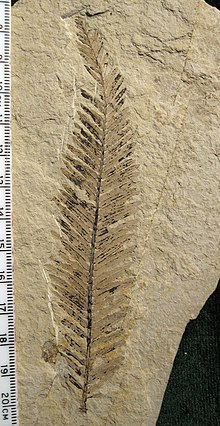
Paleontology in Oregon refers to paleontological research occurring within or conducted by people from the U.S. state of Oregon. Oregon's geologic record extends back approximately 400 million years ago to the Devonian period, before which time the state's landmass was likely submerged under water. Sediment records show that Oregon remained mostly submerged until the Paleocene period. The state's earliest fossil record includes plants, corals, and conodonts. Oregon was covered by seaways and volcanic islands during the Mesozoic era. Fossils from this period include marine plants, invertebrates, ichthyosaurs, pterosaurs, and traces such as invertebrate burrows. During the Cenozoic, Oregon's climate gradually cooled and eventually yielded the environments now found in the state. The era's fossils include marine and terrestrial plants, invertebrates, fish, amphibians, turtles, birds, mammals, and traces such as eggs and animal tracks.
Oregon has a long tradition of paleontological research. Local Native Americans devised myths to explain fossils. By the mid-19th century local fossils had come to the attention of formally trained scientists, and modern research has produced data on climate change and extinction.
The Oligocene dawn redwood Metasequoia occidentalis is the Oregon state fossil.
Prehisto Precambrian There are no known rocks in Oregon from Precambrian times. Geologists infer that the area now occupied by Oregon must have been submerged deep on the ocean floor during that period.

Paleozoic Era
Oregon's oldest known rock formations are found in the Blue Mountains and the Klamath Mountains. The state's oldest individual rock is a limestone near Suplee dated to nearly 400 million years ago, during the Devonian period of the Paleozoic era. These deposits include conodonts as well as extinct corals and brachiopods, indicating a shallow marine environment. Most of Oregon would remain under water until the Cenozoic era.
Starting in the Carboniferous period, a series of volcanic archipelagos formed in the region. Islands in these chains would have hosted warm, wet terrestrial environments. Fossils in Oregon's oldest floral assemblage, dating to the Late Carboniferous period, implies a lagoon ecosystem. Fossils in the assemblage include horsetails, ferns, scale trees, and conifer tree seeds. Formations of similar age also include shallow water invertebrates indicating that Oregon's volcanic islands were surrounded by coral reefs, which is consistent with Charles Darwin's theory of reef formation.
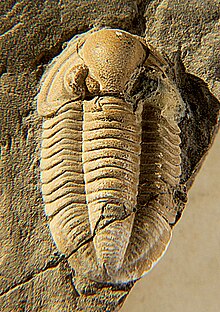
Island chains continued to form over Oregon through the Permian period. Fossil assemblages from that time are therefore similar to those from the Carboniferous, although none have been found that include any Permian plant life. One species of Permian snail found in Oregon, Acteonina permiana, lends credence to the theory of plate tectonics because of its resemblance to contemporary Eurasian species. Fragmentary remains of Permian trilobites, including the endemic species Cummingella oregonensis, have been found in the state's Coyote Butte Formation.
Mesozoic Era
Oregon remained covered by shallow seaways throughout the Mesozoic era. Rising temperatures throughout the era led to rising sea levels. Oregon's fossil flora and fauna track these environmental changes with the addition of species adapted to deeper water or more tropical terrestrial conditions.

A new series of tropical islands emerged during the Triassic period, formed by the merging of the state's older volcanic chains. The only plant fossil from Oregon's Triassic formations is Diplopora oregonensis. As in the Paleozoic, shallow water invertebrates made up Oregon's Triassic fauna. These include sponges, ammonites, radiolarians, brachiopods, and the belemnite Aulacoceras. The trace fossil Chondrites, a species of fodinichnid, has been found in the same formations. Although corals have also been found in these assemblages, paleontologists debate the presence of true coral reefs in the region during the Triassic. The oldest vertebrate fossils in Oregon's fossil record appear in Triassic-aged limestones in the Wallowa Mountains. These fossils, including vertebrae, ribs, and a partial skull, have been assigned to the early ichthyosaur genus Shastasaurus. Additionally, a new genus of basal thalattosaur has been recovered from the Brisbois Member of the Vester Formation in Central Oregon near the community of Suplee.

The breakup of the Pangaean supercontinent during the transition to the Jurassic period created a subduction zone in Oregon's ancient seaway, burying older rock formations and giving way to new volcanic island chains. Oregon's Jurassic invertebrates, such as the reef-building clam Lithiolus problematicus and the mussel-like Buchia piochii, indicate shallow sea environments similar to those of the state's late Triassic. Among Oregon's Jurassic-aged vertebrate fossils are the remains of marine crocodiles known as Zoneait. These crocodiles likely shared Oregon's Jurassic seaways with ichthyosaurs. Plant fossils from Oregon's Jurassic period show that the terrestrial environment became warmer and wetter, creating swampy conditions. These fossils, from the Coon Hollow Formation and others of similar age, include ferns, quillworts, cycads, and conifers.
Oregon's islands collided with the Laramidian continent at the end of the Jurassic, creating a new western coastline during the Cretaceous period. This coastline later developed through a combination of sea level change and mountain uplift. Global temperatures reached their maximum during the mid-Cretaceous, melting mountain ice and increasing global sea levels. As sea levels rose the Pacific grew to cover more of Oregon's landmass, eventually stopping at the base of a coastal mountain range. These mountains blocked oceanic weather systems, creating a tropical rainy environment along the ancient Oregonian coast. Although the mountain range ran along that Cretaceous coast, it was different from Oregon's modern Coast Range.

Because of the spread of seaways over Oregon during the Cretaceous, plant remains from that time period tend to be rare in the region. Those that have been found come from the state's southwest and northeast, which indicate the presence of small islands in those areas during the period. Plant fossils from these areas tend to be endemic to the region. These include species of the fern Dicksonia, cycads Ctenis and Ctenophyllum, conifers Podozamites and Taxites, seeds of the palm Attalea, and the tree-fern Tempskya. The tree-fern fossils have been found associated with ammonites, suggesting the location of an ancient shoreline. Other Cretaceous invertebrates in the region are similar to those found in Jurassic formations. Cretaceous formations in Oregon tend to include a wider variety of trace fossils, including the fodinichnids Planolites, Skolithos, Glossifungites, and Arenicolites. Oregon's oldest known crustacean, a unique species named Hoploparia riddlensis, is also of Cretaceous age.
Oregon's vertebrates become more diverse in its Cretaceous fossil record. An amateur discovery in 2005, popularly dubbed "Mitchell's Monster," shows that short-necked plesiosaurs roamed the state's Cretaceous seas along with ichthyosaurs. Other sites nearby in Wheeler County have yielded the remains of Oregon's only known pterosaur, attributed to Bennettazhia oregonensis, as well as teeth from the extinct goblin shark Scapanorhynchus. Only two non-avian dinosaur fossils have been found in Oregon, and both are isolated bones in marine rocks, which evidently bloated and floated out to sea. One is the pedal phalanx of a large (5 m long) ornithopod, intermediate in size and morphology between Tenontosaurus and Eolambia, from the Early Cretaceous (Albian) Hudspeth Shale near Mitchell, Oregon. The other is a sacrum fragment, attributable to a hadrosaur similar to Lambeosaurus, recovered from Late Cretaceous (Campanian) sandstones at Cape Sebastian on the southern Oregon coast.
There is no geological record in Oregon of the K-Pg boundary or of the event that ended the Mesozoic era.
Cenozoic Era
Oregon's paleoenvironment in the Cenozoic reflected the era's overall global cooling trend, shifting from tropical to temperate to glacial climates. Westward shift in the state's shoreline brought a more diverse terrestrial fauna, including a variety of extinct land mammals.
The state's earliest Paleogene deposits record an environment that was warm and wet, similar to the modern American southeast. Fossils from this time include pollen and leaves from ferns, spongeplants, hazelnuts, water elms, laurels, and horsetails. Trees that would become more common when temperatures later cooled, including alder and birch, made their first appearance along Oregon's Paleogene coastline. Invertebrate foramenifera from the Paleogene have been reported from sediments in Coos County, but their identity remains disputed.
Oregon's mid-to-late Paleogene fossil record is split between the ocean-covered western part of the state and the terrestrial east, where mammals made their first appearance in the state's fossil record.
In western Oregon's ocean, the new Cascadia subduction zone laid the foundations for Oregon's modern Coast Range and improved ocean productivity, prompting diversification among the state's fauna. At least 25 species of mollusk, including several snails, are known from the Fern Ridge Dam area alone. Other marine invertebrates include echinoderms, foramenifera, brachiopods, scaphopods, shrimp, and crabs. Shark teeth from over a dozen genera have been found at a variety of sites, including the Rocky Point Quarry to the west of the Nehalem River. These genera include dogfish, horn sharks, comb-toothed sharks, makos, tiger sharks, white sharks, and an archaic basking shark. Bony fish included mahi mahi, conger eels, rattails, ancestral billfish, cod, hake, and rockfish. Marine birds in the area included auks, the local species Hydrotherikornis oregonus, and the pelican-like Phocavis maritimus. The state's only known fossil egg was found in associated rock formations.
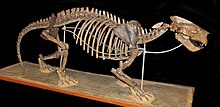
The subduction zone's volcanic activity also formed the Cascade volcanic arc, which blocked moist air from the Pacific and created the state's High Desert. This is when Oregon's fossil-rich John Day Fossil Beds were first laid down. The earliest fossils in John Day indicate a subtropical terrestrial environment. The assemblage is rich in fossil seeds, fruit nuts, and associated woods, and is one of the few places in the world where all three are preserved in a single location. The flora included cinnamon, cycads, palms, the primitive sycamore Platanophyllum angustilobus, walnuts, magnolias, figs, grapes, coffee trees, cashews, and bananas. The state's earliest known land mammals—including the rhinoceros Hyrachyus, the early horse Orohippus, and the brontothere Telmatherium—browsed these flora. Among the area's predators was Patriofelis, a cat-like creodont. These mammals shared the ecosystem with crocodiles in the genus Pristichampsus and the tortoise Hadrianus.
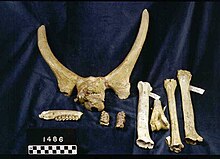
In the transition from the late Paleogene to the Neogene period, Oregon's climate became drier and its environments became more similar to those of the modern day. Grasses appeared and spread across the landscape, leaving fossilized leaves in the John Day beds. Metasequoia occidentalis, a conifer closely related to modern redwoods, flourished across the state during this time. Mammals and other fauna diversified and became more common. Early additions included camels such as Paratylopus and Gentilicamelus and pecora such as Hypertragulus. Later additions included perissodactyls such as Merychippus, Parahippus, Protapirus, and Diceratherium, artiodactyls such as Dromomeryx and Blastomeryx, and proboscids like Gomphotherium and Platybelodon. Rodents including the burrowing beaver Palaeocastor and horned gopher Mylagaulus. Predators in this time period included bear-dogs such as Amphicyon, cat-like nimravids, enteldonts, and early canids such as Cormocyon. Remains of the early primate Ekgmowechashala have also been found in the John Day fossil beds.
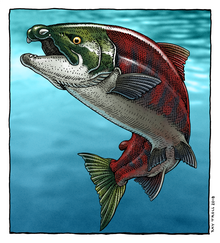
Aquatic mammals made their first appearance in Oregon along the early Neogene coast. Fossils from early pinnipeds such Enaliarctos and the primitive walrus Proneotherium have been found in Lincoln County. Kolponomos newportensis, a bear-like aquatic carnivore with features similar to saber-toothed predators, comes from nearby deposits of similar age. Whales such as Aetiocetus and the primitive mysticete Cophocetus oregonensis appear in Oregon's fossil record in this period. Sirenians and desmostylids have also been found in coastal assemblages. Paleontologists believe that animals in these two groups fed on clams and other mollusks, which is consistent with fossil clam beds found in the Coast Range. The saber-tooth salmon Oncorhynchus rastrosus also swam in Oregon's Neogene rivers. Global cooling in the late Neogene gave way to glaciation in the Quaternary. Oregon's mountain ranges were covered in large ice caps, although the Cordilleran Ice Sheet did not extend into the state. Evidence of ice cap increase and decrease is preserved in a series of glacial lakes, including Glacier Lake. Glacial erratics can be found across the northern half of the state, including sites such as the Erratic Rock State Natural Site. Pluvial lakes are also common across the state. These include Fossil Lake, which is the source of Oregon's largest Pleistocene fossil assemblage. Included in this assemblage are typical Pleistocene megafauna, including Columbian mammoths, dire wolves, Ice Age bison, camels, the ground sloths Mylodon and Megatherium, and the short-faced bear Arctodus (which was previously mistaken for its cousin Arctotherium). The assemblage also includes over 50 species of waterfowl, including grebes, cormorants, swans, gulls, flamingos, herons, and pelicans. Among the bony fish species found in Fossil Lake's assemblage are several salmon species.
Pleistocene megafauna are found across the northern half of Oregon and include such finds as the Tualatin mastodon, the McMinnville mammoth, and the Woodburn Teratornis. The Willamette Valley Pleistocene Project has reported the discovery of mammoth tracks, attributable to the ichnotaxon Proboscipeda, near the Yamhill River. A spectacular set of 117 mammoth tracks some 43,000 years old at Fossil Lake, near Christmas Valley, reveal a touching drama of wounded mother and concerned yearlings A 9-meter bear trackway, including tracks of the same size and age as Arctodus has been found near Lakeview.
Tectonic activity associated with the Cascadian Subduction Zone continued throughout the Quaternary, leaving evidence of a series of earthquakes and tsunamis in the past 60 thousand years. At the end of the Last Glacial Maximum, collapse of the ice dam surrounding Lake Missoula initiated a series of large-scale floods that inundated much of the state from 19-13 thousand years ago. Around 14 thousand years ago, the Bonneville Flood contributed more floodwaters to many of the same areas. These floods contributed to the modern fertility of the Willamette Valley by transporting soils from the east. Given the timing of these events, it is unlikely that they contributed to the extinction of Pleistocene megafauna such as mammoths and ground sloths in Oregon.
The earliest evidence of human occupation in Oregon comes from human coprolites in Paisley Caves dated to 14,300 years ago. Other early sites include an encampment near Bandon dated to around 10,000 years ago and a pair of sandals from Fort Rock Cave dated to around 9,000 years ago. The margin of error for these dates makes it possible that humans contributed to the extinction of Oregon's Pleistocene megafauna.
History
Indigenous interpretations
Ancient people living near Fossil, Oregon collected fossils as far back as 11,000 years ago and kept them at a dwelling that has since been uncovered by archeologists. Some of the fossils kept there were pierced to be made into jewelry. Five slabs of rock bearing leaf impressions were found neatly stacked in the corner of the site. These and other fossils discovered by Native Americans may have contributed to the development of local myths and lore. Historian Adrienne Mayor cites as an example the Klamath Tribes of the Modoc, who attributed local fossils to water monsters killed by the mythological figure Coyote.

Scientific research
Professional work
Oregon's first paleontologist was Thomas Condon. Condon began collecting in 1861, when a company of soldiers that arrived in Fort Dalles, where Condon served as the Congregational church pastor. The soldiers brought fossil bones and teeth, including a well-preserved rhinoceros jaw, from the John Day fossil beds. When soldiers were dispatched the following year to Harney Valley, near the fossil beds, Condon went along with them and prospected for fossils. He went fossil collecting again in 1863 and discovered rich fossil deposits north of Picture Gorge in the John Day River valley.
Condon realized that he had stumbled on a find of major scientific importance. Since he himself had no scientific qualifications or references to use in identifying fossils, Condon sent some fossils to Othniel Charles Marsh of Yale University. Marsh replied with a request for Condon to guide an expedition to the area in which he found the fossils. Condon obliged and over the ensuing years a series of fossil hunting expeditions ventured into the John Day fossil beds. A number of Condon's specimens ended up in prestigious museums like the American Museum of Natural History and Smithsonian Institution, with the bulk of his collection stored in the University of Oregon Museum of Natural and Cultural History.
Edward Drinker Cope, whose rivalry with Marsh spurred the "Bone Wars" of the late nineteenth century, also collected fossils in Oregon. His findings from the state are described in his book Vertebrata of the Tertiary Formations of the West.
In the present day, Oregon State University and the University of Oregon both maintain active research programs in paleontology. Oregon State University's Terry Lab, under the supervision of Rebecca Terry, produces research into paleoecology and Quaternary climate change. The University of Oregon's Vertebrate Paleontology Lab, under the supervision of Samantha Hopkins and Edward Davis, focuses on Oregon's extinct mammals. The University of Oregon's paleontology faculty also includes Greg Retallack, who studies fossilized soils. Many of the finds described above were collected, described, and analyzed by researchers in these programs and their predecessors.
John Day Fossil Beds National Monument, managed by the National Park Service, has also been employing paleontologists on staff since the 1980s.The current Paleontology Program Mannager is Dr. Nicholas Famoso. Recent research from the park includes volcano ecology, radiometric dating, gis applications, systematic paleontology, and mammal paleoecology.
The Oregon state legislature declared the species Metasequoia occidentalis to be Oregon's official state fossil in a resolution passed in 2005.
Amateur work
There are several organizations located in Oregon devoted to citizen science initiatives related to paleontology. Among these is the North American Research Group, which was responsible for discovery of the "Mitchell's Monster" plesiosaur and "Bernie" the Jurassic thalattosaurian. Another amateur group is the Willamette Valley Pleistocene Project, which collects from sites in McMinnville, Tualatin, Woodburn, Newberg, and King's Valley.
Notable people
Notable locations

Fossil localities
- Astoria Formation
- Blue Mountains
- Coyote Butte Formation
- Curry County
- Fossil Lake
- Keasey Formation
- Nye Formation
- Pittsburg Bluff Formation
- Wallowa Mountains
Protected areas
Natural history museums
- University of Oregon Museum of Natural and Cultural History, Eugene
- Thomas Condon Paleontology Center, John Day Fossil Beds National Monument
See also
- Paleontology in California
- Paleontology in Idaho
- Paleontology in Nevada
- Paleontology in Washington (state)
Footnotes
- ^ Fremd, Ted; Retallack, Gregory; Springer, Dale; Scotchmoor, Judy (2005). "The Paleontology Portal: Oregon, U.S." paleoportal.org. Retrieved May 18, 2017.
- ^ Bishop, Ellen Morris (2006). In search of ancient Oregon : a geological and natural history. Timber. ISBN 9780881927894. OCLC 756844383.
- ^ Orr, Elizabeth L.; Orr, William N. (2012). Oregon geology. Oregon State University Press. ISBN 9780870716812. OCLC 817068265.
- ^ Orr, Elizabeth L.; Orr, William N. (2009). Oregon Fossils. Oregon State University Press. ISBN 9780870715730. OCLC 730284504.
- Mamay, Sergius H.; Read, Charles Brian (1956). Additions to the Flora of the Spotted Ridge Formation in Central Oregon. U.S. Government Printing Office.
- "Acteonina Permiana, A New Species From The Permian Coyote Butte Formation, Central Oregon (Mollusca : Gastropoda : Actaeonidae)". Proceedings of the Biological Society of Washington. 111. 1998. ISSN 0006-324X.
- Hanger, Rex A.; Hahn, R.; Strong, E.E. (2000). "Lower Permian Trilobites from Oregon, USA". Geologica et Palaeontologica. 34: 125–135.
- Flügel, Erik; Senowbari-Daryan, Baba; Stanley, George D. (1989). "Late Triassic Dasycladacean Alga from Northeastern Oregon: Significance of First Reported Occurrence in Western North America". Journal of Paleontology. 63 (3): 374–381. doi:10.1017/s0022336000019545. JSTOR 1305509. S2CID 130316730.
- Stanley, George D.; Whalen, Michael T. (1989). "Triassic Corals and Spongiomorphs from Hells Canyon, Wallowa Terrane, Oregon". Journal of Paleontology. 63 (6): 800–819. doi:10.1017/s0022336000036490. JSTOR 1305645. S2CID 131404622.
- Orr, William N. (1987). "A Norian (Late Triassic) ichthyosaur from the Martin Bridge Limestone, Wallowa Mountains, Oregon". U.S. Geological Survey Professional Papers. 1435: 41–47.
- Metz, Eric T. (2019). Description, phylogenetic analysis and taphonomy of a new Thalattosaur from the Brisbois member of the Vester Formation (Carnian/Norian) of central Oregon (ms thesis). University of Alaska Fairbanks.
- Wilberg, E. W. (2015). "A new metriorhynchoid (Crocodylomorpha, Thalattosuchia) from the Middle Jurassic of Oregon and the evolutionary timing of marine adaptations in thalattosuchian crocodylomorphs". Journal of Vertebrate Paleontology. 35 (2): e902846. doi:10.1080/02724634.2014.902846. S2CID 83587692.
- Bland, Andrew; Rose, Robert; Currier, Aaron D. (2005). "Jurassic crocodile discovered in Crook County, Oregon" (PDF). Oregon Geology. 68: 24–26.
- Feldmann, Rodney M. (May 1, 1974). "Hoploparia riddlensis, a new species of lobster (Decapoda; nephropidae) from the Days Creek Formation (Hauterivian, Lower Cretaceous) of Oregon". Journal of Paleontology. 48 (3): 586–593. ISSN 0022-3360.
- "Oregon Paleo Lands Center (OPLI)". Oregon Paleo Lands Center (OPLI). Retrieved June 7, 2017.
- Retallack, Gregory J.; Theodor, Jessica M.; Davis, Edward B.; Hopkins, Samantha S.; Barrett, Paul Z. (2018). "First Oregon dinosaur (Ornithopoda) from Early Cretaceous (Albian) of Oregon, U.S.A." (PDF). Journal of Vertebrate Paleontology: 1–5. doi:10.1080/02724634.2018.1486847. S2CID 91379584.
- Taylor, David G.; Lucas, Spencer G. (2018). "A Late Cretaceous (Campanian) hadrosaur sacrum from the Cape Sebastian Sandstone, Curry County, Oregon". New Mexico Museum of Natural History and Science Bulletin. 79: 695–702.
- Gordon, I. (1985). "The Paleocene Denning Spring flora of north-central Oregon". Oregon Geology. 47: 115–118.
- Miles, Gregory A. (January 1, 1981). "Planktonic foraminifers of the lower Tertiary Roseburg, Lookingglass, and Flournoy Formations (Umpqua Group), southwest Oregon". Pacific Northwest Cenozoic Biostratigraphy. Geological Society of America Special Papers. Vol. 184. pp. 85–104. doi:10.1130/SPE184-p85. ISBN 978-0-8137-2184-2. ISSN 0072-1077.
- Bukry, David; Snavely, Parke D. Jr. (1988). "Coccolith Zonation for Paleogene Strata in the Oregon Coast Range". Pacific Section SEPM: 251–264.
- Steere, M.L. (1958). "Fossil localities of the Eugene area, Oregon" (PDF). The Ore Bin. 20: 51–62.
- Welton, Bruce J. (2013). A New Archaic Basking Shark (Lamniformes: Cetorhinidae) from the Late Eocene of Western Oregon, U.S.A., and Description of the Dentition, Gill Rakers and Vertebrae of the Recent Basking Shark Cetorhinus maximus (Gunnerus): Bulletin 58. New Mexico Museum of Natural History and Science.
- University of California Publications: Bulletin of the Department of Geological Sciences. University of California Press. 1932.
- Symposium, Society of Avian Paleontology and Evolution (2002). Proceedings of the 5th Symposium of the Society of Avian Paleontology and Evolution: Beijing, 1-4 June 2000. 科学出版社. ISBN 9787030105516.
- "John Day Fossil Beds". oregonencyclopedia.org. Retrieved June 4, 2017.
- "KBD: Kew Bibliographic Databases: Detailed results". kbd.kew.org. Retrieved June 10, 2017.
- Woodburne, M. O.; Robinson, P. T. (1977). "A New Late Hemingfordian Mammal Fauna from the John Day Formation, Oregon, and Its Stratigraphic Implications". Journal of Paleontology. 51 (4): 750–757. JSTOR 1303741.
- Prothero, Donald R.; Emry, Robert J. (September 29, 2005). The Terrestrial Eocene-Oligocene Transition in North America. Cambridge University Press. ISBN 9780521021098.
- Retallack, Gregory J (May 20, 2004). "Late Oligocene bunch grassland and early Miocene sod grassland paleosols from central Oregon, USA". Palaeogeography, Palaeoclimatology, Palaeoecology. Evolution of grass-dominated ecosystems during the late Cenozoic Session at the North American Paleontological Convention, 2001. 207 (3): 203–237. Bibcode:2004PPP...207..203R. doi:10.1016/j.palaeo.2003.09.027.
- Retallack, Gregory J.; Orr, William N.; Prothero, Donald R.; Duncan, Robert A.; Kester, Paul R.; Ambers, Clifford P. (2004). "Eocene-Oligocene extinction and paleoclimatic change near Eugene, Oregon" (PDF). Geological Society of America Bulletin. 116 (7): 817. Bibcode:2004GSAB..116..817R. doi:10.1130/b25281.1.
- Hartwig, Walter Carl (2002). The primate fossil record. Cambridge University Press. p. 544. Bibcode:2002prfr.book.....H. ISBN 9780521663151. OCLC 47254191.
- Deméré, Thomas A.; Berta, Annalisa (July 20, 2001). "A reevaluation of Proneotherium repenningi from the Miocene Astoria Formation of Oregon and its position as a basal odobenid (Pinnipedia: Mammalia)". Journal of Vertebrate Paleontology. 21 (2): 279–310. doi:10.1671/0272-4634(2001)021[0279:AROPRF]2.0.CO;2. ISSN 0272-4634. S2CID 88095414.
- Tseng, Z. Jack; Grohé, Camille; Flynn, John J. (March 16, 2016). "A unique feeding strategy of the extinct marine mammal Kolponomos: convergence on sabretooths and sea otters". Proc. R. Soc. B. 283 (1826): 20160044. doi:10.1098/rspb.2016.0044. ISSN 0962-8452. PMC 4810869. PMID 26936242.
- Hannibal, Harold (1922). "Notes on Tertiary Sirenians of the Genus Desmostylus". Journal of Mammalogy. 3 (4): 238–240. doi:10.2307/1373255. JSTOR 1373255.
- Beatty, Brian Lee; Cockburn, Thomas C. (September 3, 2015). "New insights on the most primitive desmostylian from a partial skeleton of Behemotops (Desmostylia, Mammalia) from Vancouver Island, British Columbia". Journal of Vertebrate Paleontology. 35 (5): e979939. doi:10.1080/02724634.2015.979939. ISSN 0272-4634. S2CID 129905948.
- Claeson, Kerin M.; Davis, E. B.; Sidlauskas, B. L.; Prescott, Z. M. (2016). The Sabertooth Salmon, Oncorhynchus rastrosus, gets a facelift (Report).
- "Glacier National Park (U.S. National Park Service)". www.nps.gov. Retrieved June 4, 2017.
- Elftman, Herbert Oliver (1931). "Pleistocene mammals of Fossil Lake, Oregon" (PDF). American Museum Novitates (481): 1–21.
- "Tualatin's Mastodon". The City of Tualatin Oregon Official Website. Retrieved June 11, 2017.
- "The McMinnville Mammoth Site | Institute for Archaeological Studies". prehistoricterritory.org. Retrieved June 11, 2017.
- "Ice Age Fossils of Woodburn, Oregon" (PDF).
- "Mammoth Tracks Prove Beasts Once Roamed Oregon". www.opb.org. Retrieved June 11, 2017.
- Retallack, Gregory J.; Martin, James E.; Brozs, Adrian P.; Breithaupt, Brent H.; Matthews, Neffra A.; Walton, Dean P. (2018). "Late Pleistocene trackway from Fossil Lake, Oregon". Palaeogeography, Palaeoclimatology, Palaeoecology. 496: 192–204. doi:10.1016/j.palaeo.2018.01.037.
- Packard, E.L.; Allison, I.S.; Cressman, L.S. "Mammalian Tracks in the Late Pliocene or Early Pleistocene Beds of Lake County Oregon" (PDF). Oregon Geology. Retrieved June 11, 2017.
- ^ Murray, Marian (1967). Hunting for Fossils. A Guide to Finding and Collecting Fossils in All 50 States. Macmillan.
- Adams, John (August 1, 1990). "Paleoseismicity of the Cascadia Subduction Zone: Evidence from turbidites off the Oregon-Washington Margin". Tectonics. 9 (4): 569–583. Bibcode:1990Tecto...9..569A. doi:10.1029/tc009i004p00569. ISSN 1944-9194.
- Kelsey, Harvey M.; Nelson, Alan R.; Hemphill-Haley, Eileen; Witter, Robert C. (2005). "Tsunami history of an Oregon coastal lake reveals a 4600 yr record of great earthquakes on the Cascadia subduction zone". Geological Society of America Bulletin. 117 (7): 1009. Bibcode:2005GSAB..117.1009K. doi:10.1130/b25452.1.
- "Cave containing earliest human DNA dubbed historic". Retrieved June 12, 2017.
- Emery-Wetherell, Meaghan; McHorse, Brianna; Davis, Edward (June 1, 2017). "Megafaunal Extinction". Data from: Spatially explicit analysis sheds new light on the Pleistocene megafaunal extinction in North America. Dryad Digital Repository. doi:10.5061/dryad.5s3b1.
- Mayor, Adrienne (2005). Fossil legends of the first Americans. Princeton University Press. ISBN 978-0691113456. OCLC 55596904.
- Cope, E. D. (1877). "Descriptions of New Vertebrata from the Upper Tertiary Formations of the West". Proceedings of the American Philosophical Society. 17 (100): 219–231. JSTOR 982301.
- Badgley, Catherine; Smiley, Tara M.; Terry, Rebecca; Davis, Edward B.; DeSantis, Larisa R. G.; Fox, David L.; Hopkins, Samantha S. B.; Jezkova, Tereza; Matocq, Marjorie D. (March 1, 2017). "Biodiversity and Topographic Complexity: Modern and Geohistorical Perspectives". Trends in Ecology & Evolution. 32 (3): 211–226. doi:10.1016/j.tree.2016.12.010. PMC 5895180. PMID 28196688.
- Smiley, Tara M; Terry, Rebecca C (January 1, 2001). eLS. John Wiley & Sons, Ltd. doi:10.1002/9780470015902.a0003274.pub2. ISBN 9780470015902.
- Kathleen Lyons, S.; Amatangelo, Kathryn L.; Behrensmeyer, Anna K.; Bercovici, Antoine; Blois, Jessica L.; Davis, Matt; DiMichele, William A.; Du, Andrew; Eronen, Jussi T. (January 7, 2016). "Holocene shifts in the assembly of plant and animal communities implicate human impacts". Nature. 529 (7584): 80–83. Bibcode:2016Natur.529...80K. doi:10.1038/nature16447. ISSN 0028-0836. PMID 26675730. S2CID 4449162.
- Terry, Rebecca C.; Rowe, Rebecca J. (August 4, 2015). "Energy flow and functional compensation in Great Basin small mammals under natural and anthropogenic environmental change". Proceedings of the National Academy of Sciences. 112 (31): 9656–9661. Bibcode:2015PNAS..112.9656T. doi:10.1073/pnas.1424315112. ISSN 0027-8424. PMC 4534246. PMID 26170294.
- Rowe, Rebecca J.; Terry, Rebecca C. (December 1, 2014). "Small mammal responses to environmental change: integrating past and present dynamics". Journal of Mammalogy. 95 (6): 1157–1174. doi:10.1644/13-MAMM-S-079. ISSN 0022-2372.
- Levering, David; Hopkins, Samantha; Davis, Edward (January 15, 2017). "Increasing locomotor efficiency among North American ungulates across the Oligocene-Miocene boundary". Palaeogeography, Palaeoclimatology, Palaeoecology. 466: 279–286. Bibcode:2017PPP...466..279L. doi:10.1016/j.palaeo.2016.11.036.
- Mchorse, Brianna K.; Davis, Edward Byrd; Scott, Eric; Jenkins, Dennis L. (November 1, 2016). "What species of horse was coeval with North America's earliest humans in the Paisley Caves?". Journal of Vertebrate Paleontology. 36 (6): e1214595. doi:10.1080/02724634.2016.1214595. ISSN 0272-4634. S2CID 89594150.
- McLaughlin, Win N. F.; Hopkins, Samantha S. B.; Schmitz, Mark D. (September 2, 2016). "A new late Hemingfordian vertebrate fauna from Hawk Rim, Oregon, with implications for biostratigraphy and geochronology". Journal of Vertebrate Paleontology. 36 (5): e1201095. doi:10.1080/02724634.2016.1201095. ISSN 0272-4634. S2CID 133456715.
- Famoso, Nicholas A.; Davis, Edward Byrd (July 6, 2016). "On the relationship between enamel band complexity and occlusal surface area in Equids (Mammalia, Perissodactyla)". PeerJ. 4: e2181. doi:10.7717/peerj.2181. ISSN 2167-8359. PMC 4941743. PMID 27441119.
- Stilson, Kelsey T.; Hopkins, Samantha S. B.; Davis, Edward Byrd (February 3, 2016). "Osteopathology in Rhinocerotidae from 50 Million Years to the Present". PLOS ONE. 11 (2): e0146221. Bibcode:2016PLoSO..1146221S. doi:10.1371/journal.pone.0146221. ISSN 1932-6203. PMC 4739690. PMID 26840633.
- Famoso, Nicholas A.; Davis, Edward Byrd; Feranec, Robert S.; Hopkins, Samantha S. B.; Price, Samantha A. (March 1, 2016). "Are Hypsodonty and Occlusal Enamel Complexity Evolutionarily Correlated in Ungulates?". Journal of Mammalian Evolution. 23 (1): 43–47. doi:10.1007/s10914-015-9296-7. ISSN 1064-7554. S2CID 16208691.
- Retallack, Greg J. (January 1, 1988). "Field recognition of paleosols". Paleosols and Weathering Through Geologic Time: Principles and Applications. Geological Society of America Special Papers. Vol. 216. pp. 1–20. doi:10.1130/SPE216-p1. ISBN 978-0-8137-2216-0. ISSN 0072-1077.
- Retallack, Gregory J. (April 30, 2008). Soils of the Past: An Introduction to Paleopedology. John Wiley & Sons. ISBN 9780470698167.
- "House Joint Resolution 0003". www.oregonlegislature.gov. Retrieved June 5, 2017.
- "Mitchell's Monster | Mitchell Oregon". mitchelloregon.us. Retrieved June 11, 2017.
References
- Bishop, Ellen Morris. 2003. In Search of Ancient Oregon: A Geological and Natural History. Timber Press. 288 pp.
- Fremd, Ted, Greg Retallack, Dale Springer, Judy Scotchmoor. July 1, 2005. "Oregon, US." The Paleontology Portal. Accessed September 21, 2012.
- Mayor, Adrienne. Fossil Legends of the First Americans. Princeton University Press. 2005. ISBN 0-691-11345-9.
- Murray, Marian (1974). Hunting for Fossils: A Guide to Finding and Collecting Fossils in All 50 States. Collier Books. p. 348. ISBN 978-0-02-093550-6.
- Orr, Elizabeth L. and Orr, William N. 2009. Oregon Fossils (Second Edition). Oregon State University Press. 300 pp.
- Orr, Elizabeth L. and Orr, William N. 2012. Oregon Geology (Sixth Edition). Oregon State University Press. 304 pp.